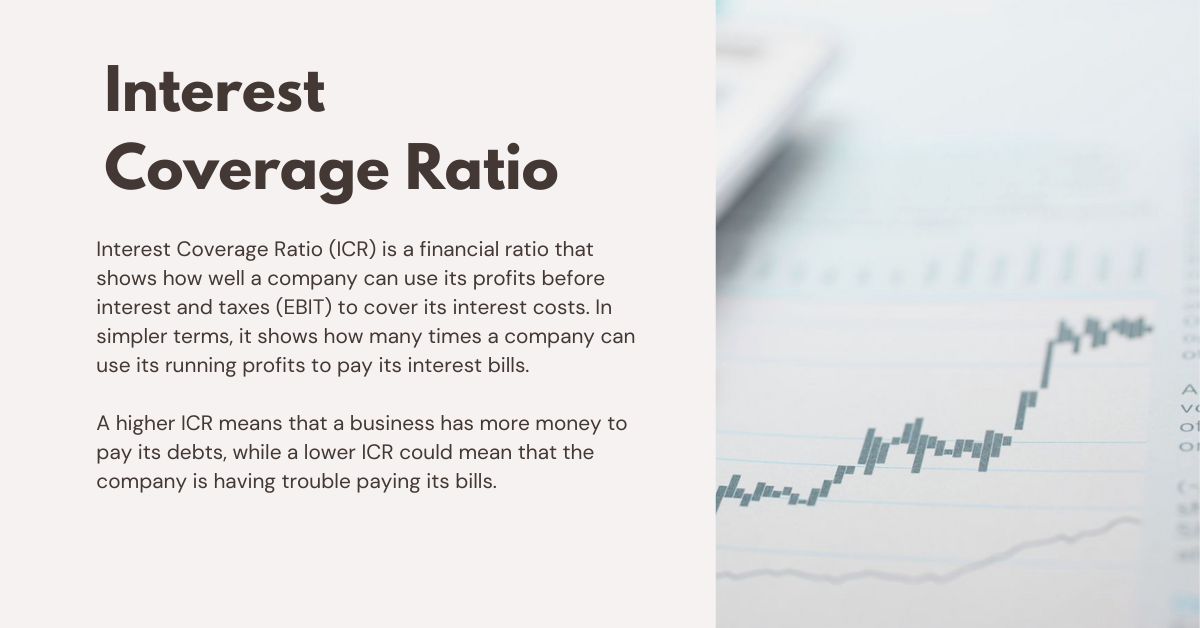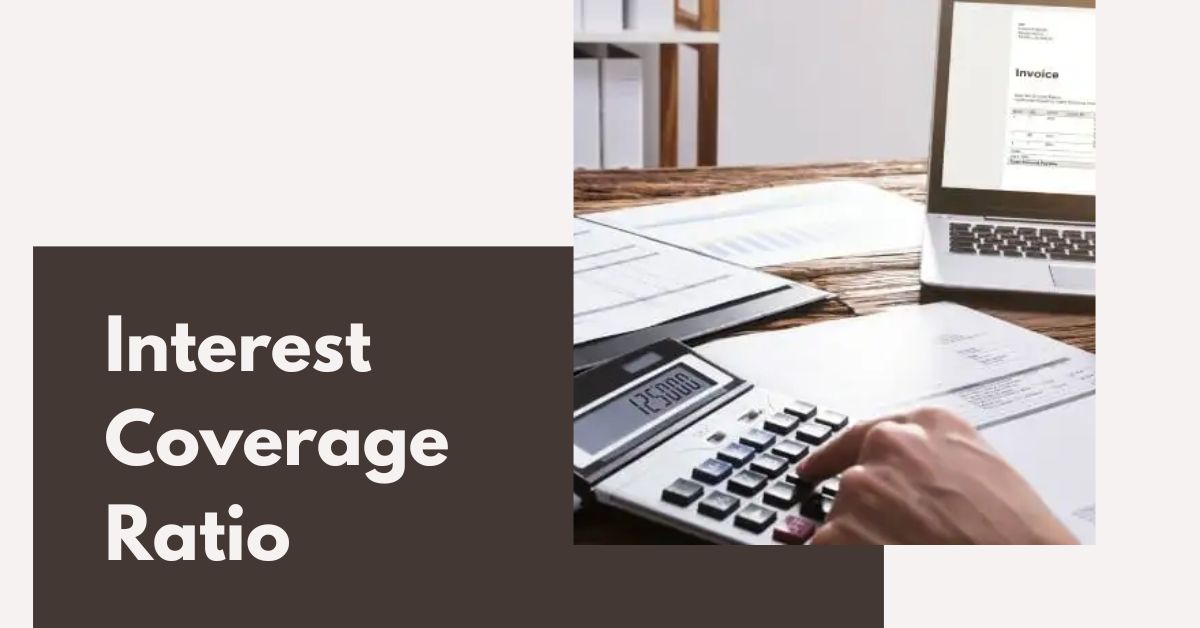The interest coverage ratio can be a very useful tool for risk management because it tells you if your company makes enough money to pay the interest on its debts. Start with our interest coverage ratio definition to learn everything you need to know.
What is Interest Coverage Ratio?

Interest Coverage Ratio (ICR) is a financial ratio that shows how well a company can use its profits before interest and taxes (EBIT) to cover its interest costs. In simpler terms, it shows how many times a company can use its running profits to pay its interest bills. A higher ICR means that a business has more money to pay its debts, while a lower ICR could mean that the company is having trouble paying its bills.
How to Calculate Interest Coverage Ratio?
In order to calculate the Interest Coverage Ratio (ICR), two basic figures are required from a company’s financial statements: Earnings Before Interest and Taxes (EBIT) and Interest Expense.
EBIT, or earnings before interest and taxes, refers to the company’s operating profit before subtracting interest and taxes. Interest Expense refers to the total amount of interest that the corporation has paid on its outstanding commitments. The equation used for calculating the Interest Coverage Ratio (ICR) is:
ICR = EBIT / Interest Expense
For example, if a company’s Earnings Before Interest and Taxes (EBIT) are $10 million and their Interest Expense is $2 million, the Interest Coverage Ratio (ICR) is calculated as 10 million divided by 2 million, yielding a ratio of 5. This means that the company’s operational income is enough to cover its interest costs fivefold.
Types of Interest Coverage Ratios
The Interest Coverage Ratio has multiple variations, each with its own calculation and interpretation:
- Basic Interest Coverage Ratio: This calculation divides EBIT by interest expense and is the most popular.
- Times Interest Earned (TIE): This is another term for the Basic Interest Coverage Ratio.
- Adjusted Interest Coverage Ratio: This version takes into account non-operating income and expenses, such as gains or losses from investments.
- Fixed Charge Coverage Ratio: This ratio includes fixed charges such as lease payments and depreciation in addition to interest expense.
- Debt Service Coverage Ratio: This ratio considers both principal and interest payments on debt.
The type of interest coverage ratio that is used will be based on the specific circumstances and goals of the investigation. For example, if you want to measure a company’s capacity to satisfy its debt commitments, the Debt Service Coverage Ratio could be more useful.
What the Ratio Means for Investors?
For investors, the Interest Coverage Ratio (ICR) is very important because it shows how stable a company’s finances are and how well it can pay its debts. A bigger ICR means that a company has enough money to make its interest payments, which means it is less likely to go bankrupt.
On the other hand, a smaller ICR could mean that money is tight and that it might be hard to meet debt obligations. By comparing a company’s ICR to others in the same field, investors can get a better idea of how healthy its finances are overall and decide if it’s a good investment.
Uses of Interest Coverage Ratio
- Financial Stability: It assesses a company’s capacity to meet its interest expenses.
- Evaluating Debt Risk: A greater ICR suggests a reduced likelihood of default.
- Comparing to Industry Peers: It enables the comparison of a company’s financial health within its industry.
- Making Investment Decisions: Investors can utilize ICR to evaluate the risk and potential return on an investment.
- Monitoring Financial Performance: It allows you to track a company’s financial performance over time.
- Evaluating Debt Capacity: It assesses a company’s ability to incur extra debt.
- Lenders utilize ICR to assess a borrower’s creditworthiness.
Limitations of the Interest Coverage Ratio
- The ICR’s primary focus is on short-term solvency, which may not completely capture long-term financial problems.
- Non-Cash Expenses: The ICR excludes non-cash expenses such as depreciation and amortization, which can have an impact on a company’s overall financial health.
- Capital Structure: If a company’s capital structure is complex and includes both debt and equity, the ICR might not accurately represent its financial risk.
- Economic Cycles: Changes in interest rates or economic conditions might impair a company’s ability to create sufficient earnings, which may have an impact on the ICR.
- Qualitative elements: The ICR excludes qualitative elements such as management quality, industry trends, and competitive pressures, all of which can have an impact on a company’s financial performance.
- Debt Maturity: The ICR does not take into account a company’s debt maturity profile, which may have an impact on its capacity to satisfy future obligations.
What Does Negative Interest Coverage Ratio Mean?
A negative Interest Coverage Ratio (ICR) shows that a company’s profits before interest and taxes (EBIT) do not cover its interest expenses. This circumstance raises huge red flags for investors since it indicates that the company is failing to satisfy its financial obligations.
Reduced revenues, rising costs, or high levels of debt are just a few of the factors that can result in a negative ICR. If a company continues to operate with a negative ICR, it may suffer financial challenges, including insolvency or restructuring.
What is a Good Interest Coverage Ratio?
A good Interest Coverage Ratio (ICR) varies according to the industry and company’s individual conditions. However, an ICR of 2 or greater is commonly regarded as a positive indicator of financial stability. This signifies that a company’s operating profits are sufficient to meet its interest payments.
A higher ICR, such as three or four, indicates even better financial health and a lesser danger of default. In addition to the ICR, other criteria to evaluate include the company’s overall financial performance, industry trends, and economic conditions.
What is a Good EBITDA to Interest Coverage Ratio?
A suitable EBITDA to Interest Coverage Ratio (EBITDAR) depends on the industry and a company’s individual conditions. However, a ratio of 3 or greater is generally seen as healthy. This implies that a company’s earnings before interest, taxes, depreciation, and amortization (EBITDA) are sufficient to cover its interest payments.
A greater EBITDAR indicates better financial health and a reduced chance of default. In addition to EBITDAR, other aspects to evaluate include the company’s overall financial performance, industry trends, and economic conditions.
Is a Higher or Lower EBITDA Ratio Better?
Whether a higher or lower EBITDA ratio is preferable depends on the circumstances and industry. Generally, a greater EBITDA ratio indicates better financial health and a lesser chance of default. This is because a larger ratio indicates that a corporation can more readily cover its interest and fixed costs from operational income.
Other things to evaluate include the company’s future growth prospects, industry trends, and competitive landscape. For example, in businesses with large capital expenditures, a lower EBITDA ratio may be acceptable if the company invests in growth potential. Finally, the optimal EBITDA ratio will differ depending on the individual company and its unique conditions.

